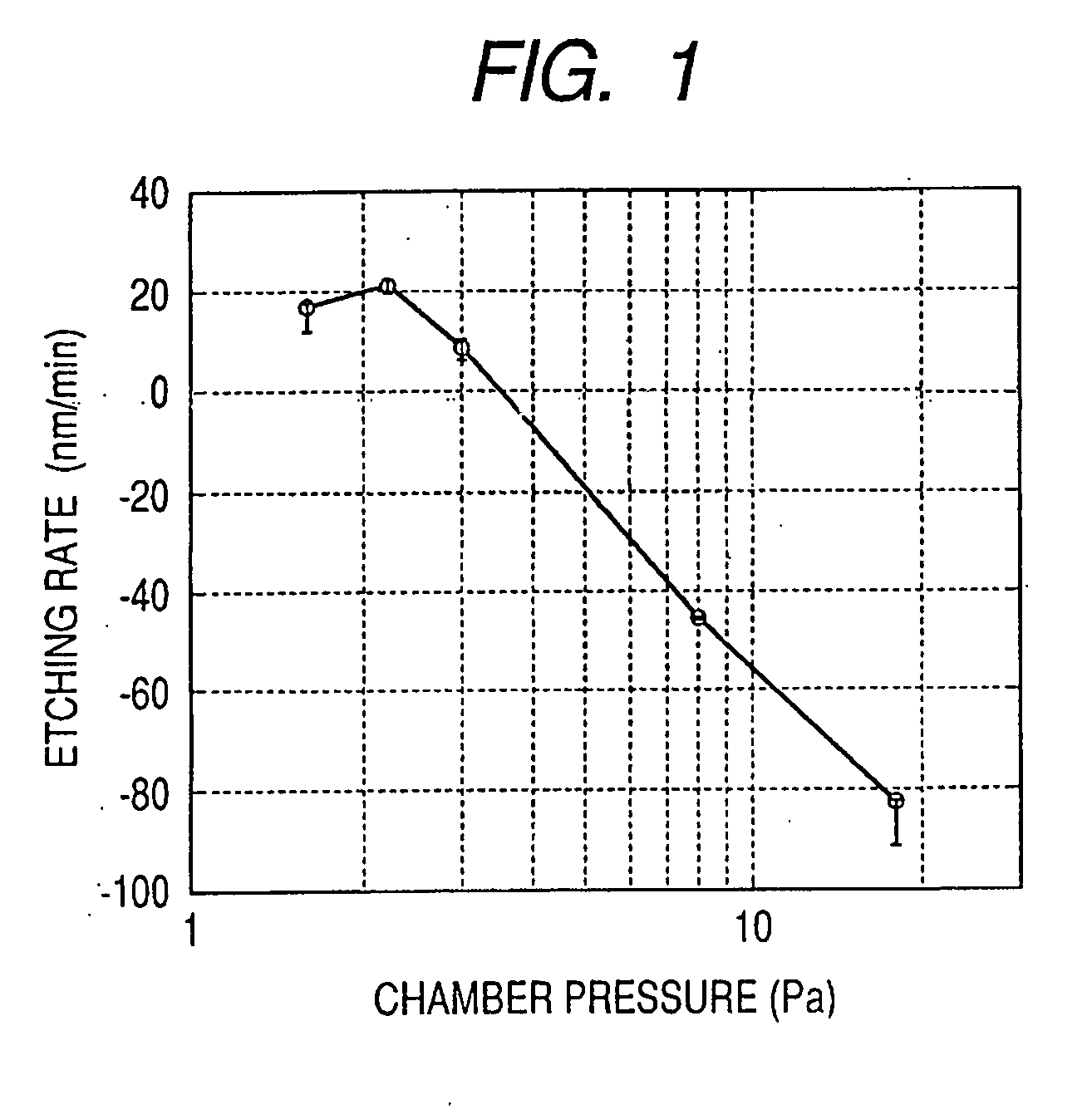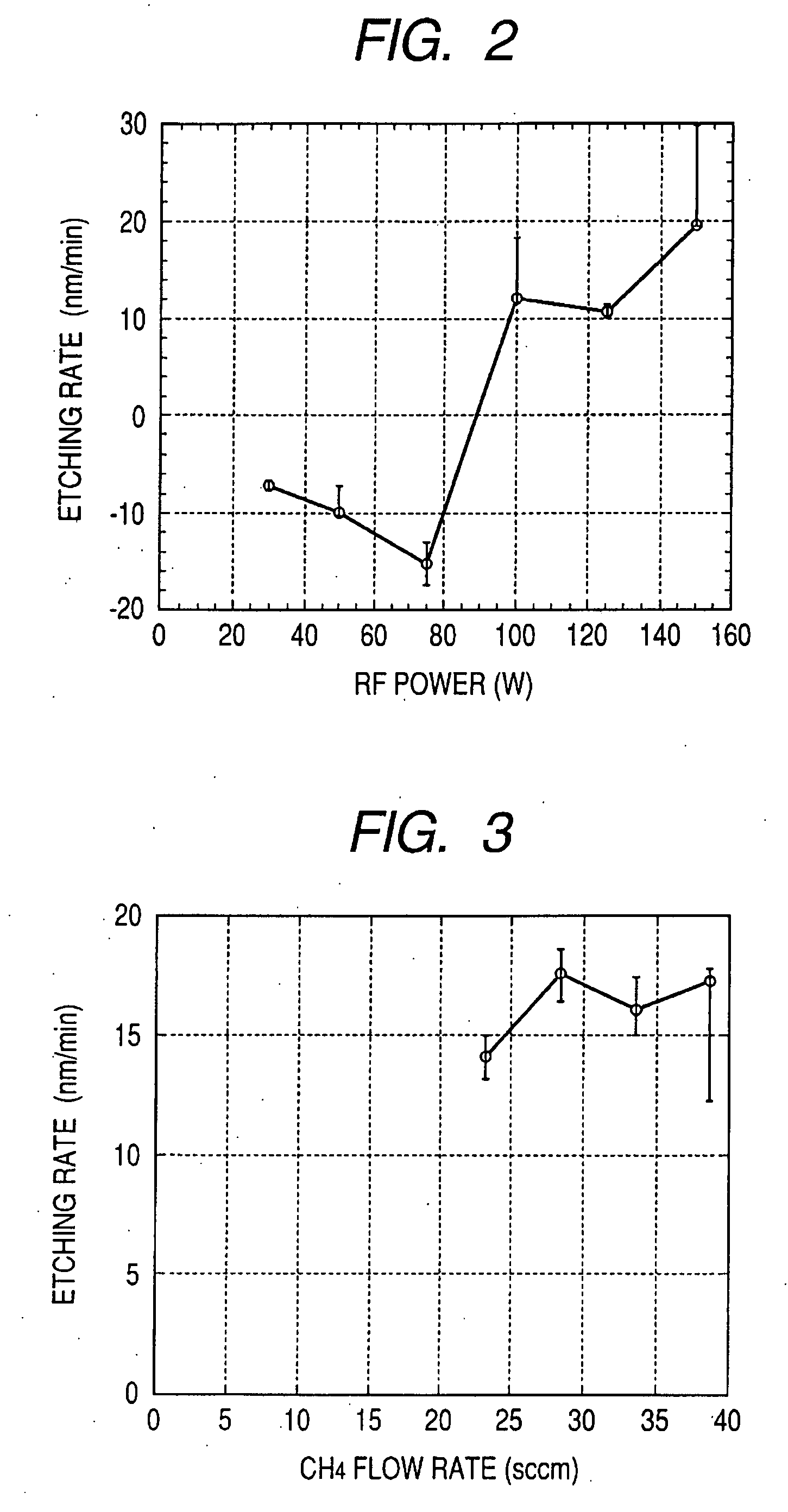Dry etching method for oxide semiconductor film
a technology of oxide semiconductor film and etching method, which is applied in the direction of semiconductor devices, decorative arts, photovoltaic energy generation, etc., can solve the problems of high temperature melted and deformed photoresist, low production yield, and liable to break the wiring provided through the patterned edge, etc., to achieve high etching rate, high processing accuracy, and high processing accuracy
- Summary
- Abstract
- Description
- Claims
- Application Information
AI Technical Summary
Benefits of technology
Problems solved by technology
Method used
Image
Examples
example 1
[0053]In Example 1, pressure dependency of an etching effect was observed. The observation of the pressure dependency was performed under such conditions that temperature was set to a room temperature, a pure CH4 flow rate was 38.7 sccm, and an RF power was 100 W (2.2 W / cm2). Results of the observation are illustrated in FIG. 1. An axis of abscissa indicates a chamber pressure, and an axis of ordinate indicates an etching rate. In FIG. 1, each negative value of the etching rate indicates a formation rate of a deposit. As a result, it was found that the dry etching can be excellently performed without forming a nonvolatile deposit in a case where the pressure was 3.5 Pa or lower. Note that, in the etching apparatus of this example, it was found that plasma was hardly excited in a case were the pressure was 0.6 Pa or lower. The lower the reactive pressure is set, the more the generation of the deposit can be suppressed. Accordingly, as long as the plasma can be excited at lower pressu...
example 2
[0055]In Example 2, a relationship between an etching effect and an RF power was observed. The observation was performed under such conditions that temperature was set to a room temperature, a pure CH4 flow rate was 38.7 sccm, and a chamber pressure was 2.6 Pa. Results of the observation are illustrated in FIG. 2. An axis of abscissa indicates an RF power, and an axis of ordinate indicates an etching rate. In FIG. 2, each negative value of the etching rate indicates a formation rate of a deposit. As apparent from FIG. 2, it was found that the dry etching can be excellently performed without forming a nonvolatile deposit in a case where the RF power was 90 W or more. In a case were the RF power is 90 W or lower, the nonvolatile deposit is formed. It is assumed that, this is because, ions in the plasma have high kinetic energy when the RF power is high, and if a deposit may be formed, the deposit is to be etched again. In the etching apparatus of this example, an applied electrode has...
example 3
[0057]In Example 3, a relationship between an etching effect and a pure CH4 flow rate was observed. The observation was performed under such conditions that temperature was set to a room temperature, an RF power was 100 W (2.2 W / cm2), and a chamber pressure was 1.6 Pa. Results of the observation are illustrated in FIG. 3. An axis of abscissa indicates a CH4 flow rate, and an axis of ordinate indicates an etching rate. As apparent from FIG. 3, in a case where the CH4 flow rate is 23 sccm or lower, the plasma is hardly excited, so it is difficult to obtain data thereof. In a case were the CH4 flow rate is 23 sccm or more, it is found that the dry etching is excellently performed without forming the nonvolatile deposit. As illustrate in FIG. 3, it is assumed that, when the CH4 flow rate is 28 sccm or more, the CH4 flow rate is in a range of a surface reaction controlled rate, and when the CH4 flow rate is 28 sccm or lower, the CH4 flow rate is in a range of a supply controlled rate. In...
PUM
| Property | Measurement | Unit |
|---|---|---|
| Temperature | aaaaa | aaaaa |
| Temperature | aaaaa | aaaaa |
| Pressure | aaaaa | aaaaa |
Abstract
Description
Claims
Application Information
 Login to View More
Login to View More - R&D
- Intellectual Property
- Life Sciences
- Materials
- Tech Scout
- Unparalleled Data Quality
- Higher Quality Content
- 60% Fewer Hallucinations
Browse by: Latest US Patents, China's latest patents, Technical Efficacy Thesaurus, Application Domain, Technology Topic, Popular Technical Reports.
© 2025 PatSnap. All rights reserved.Legal|Privacy policy|Modern Slavery Act Transparency Statement|Sitemap|About US| Contact US: help@patsnap.com



